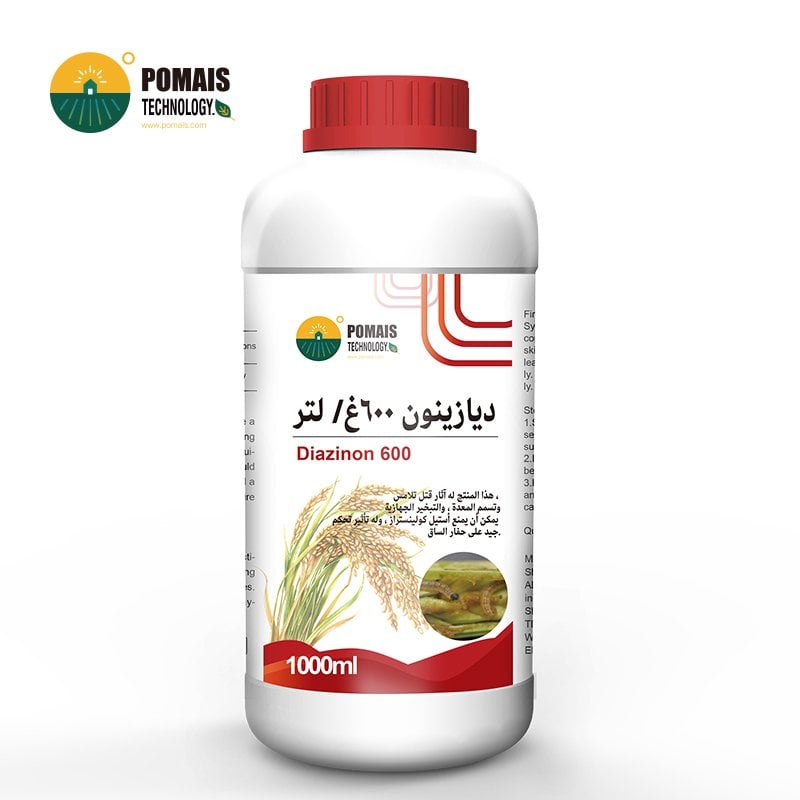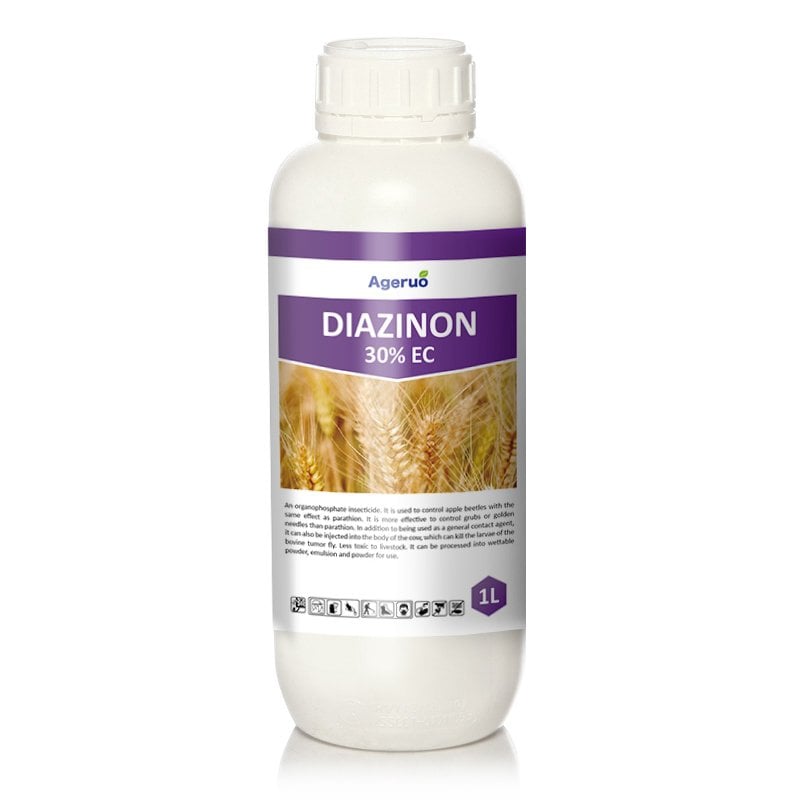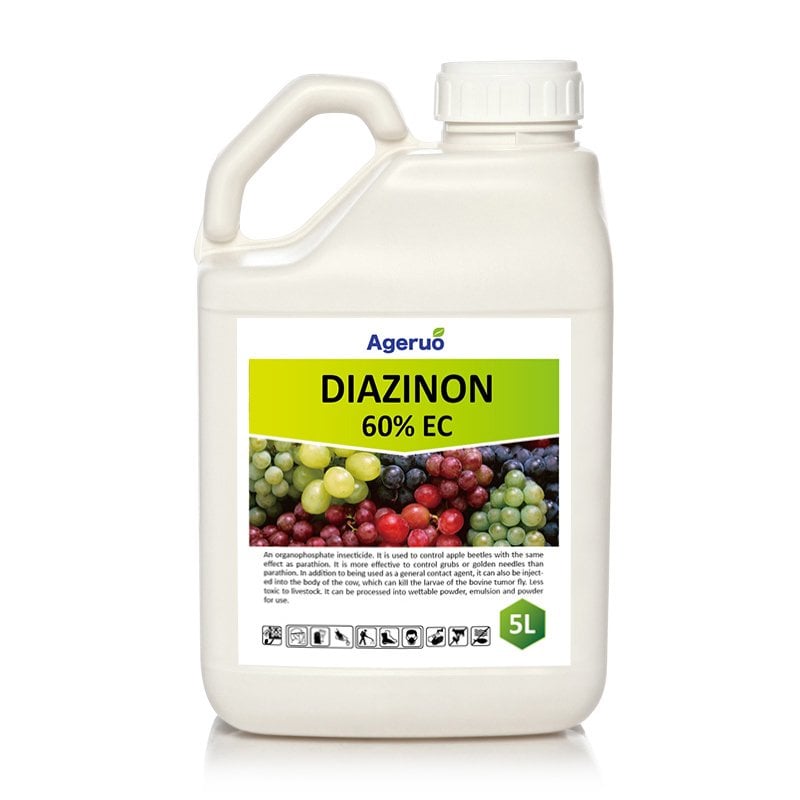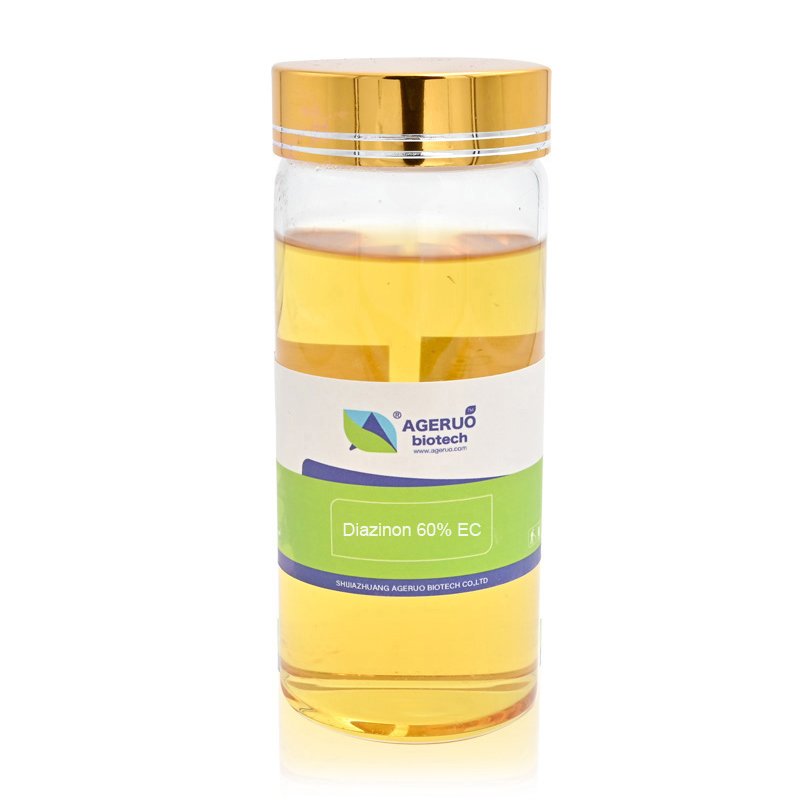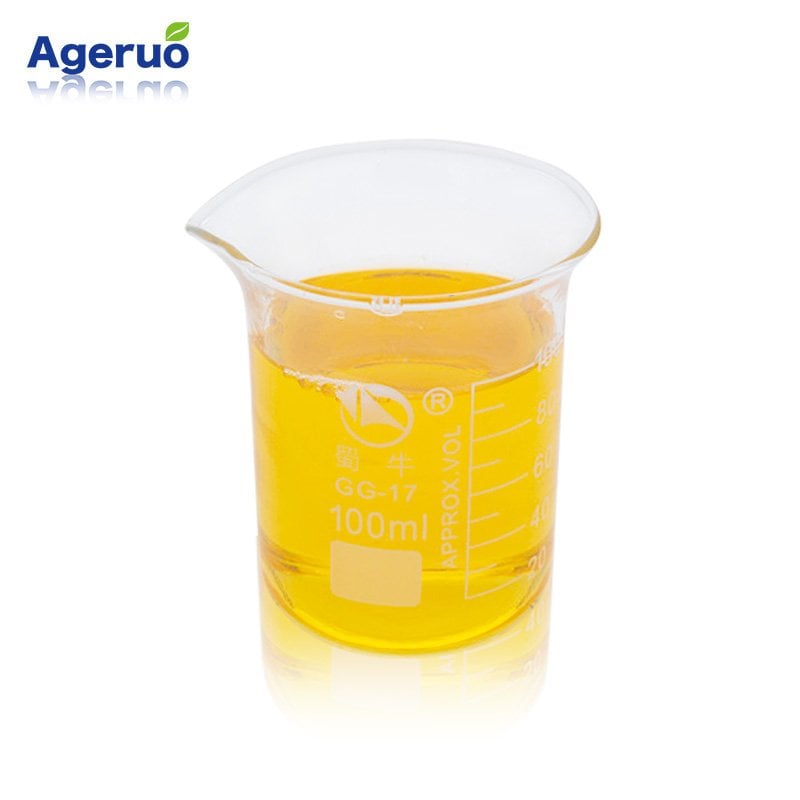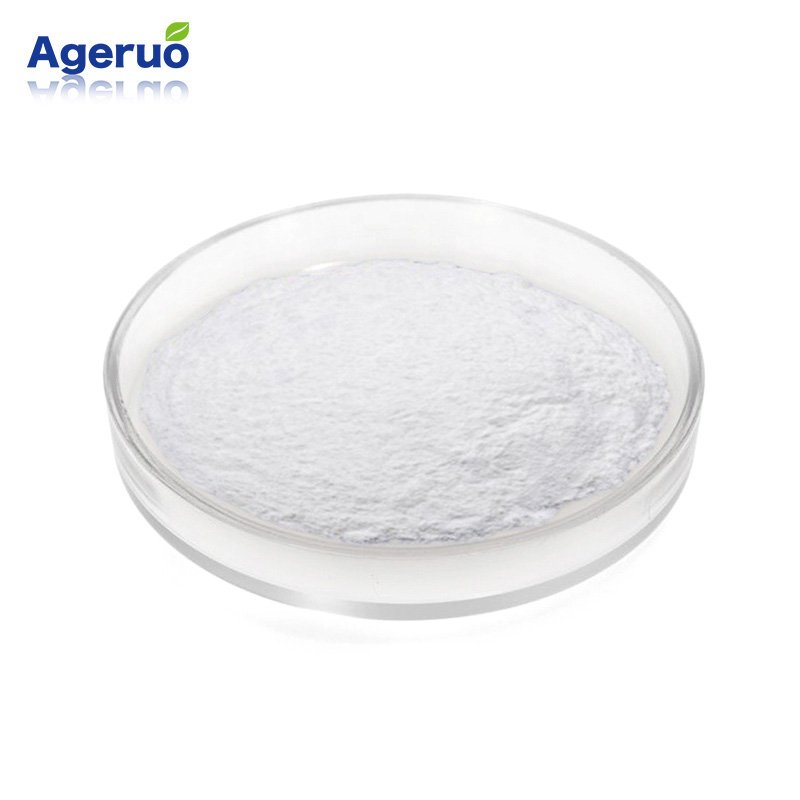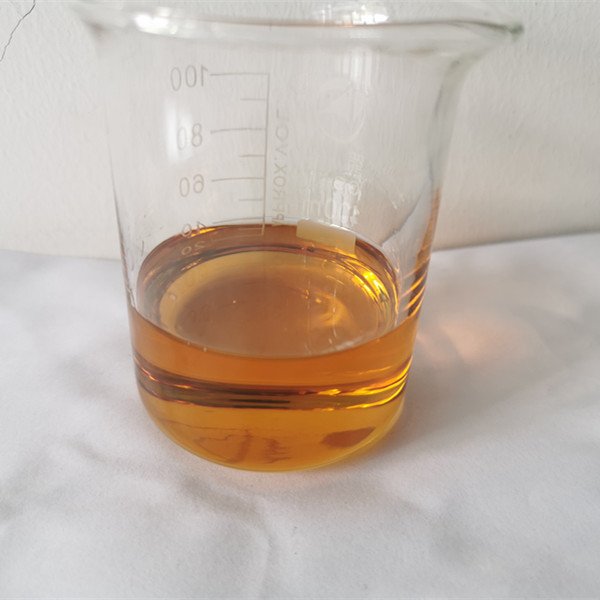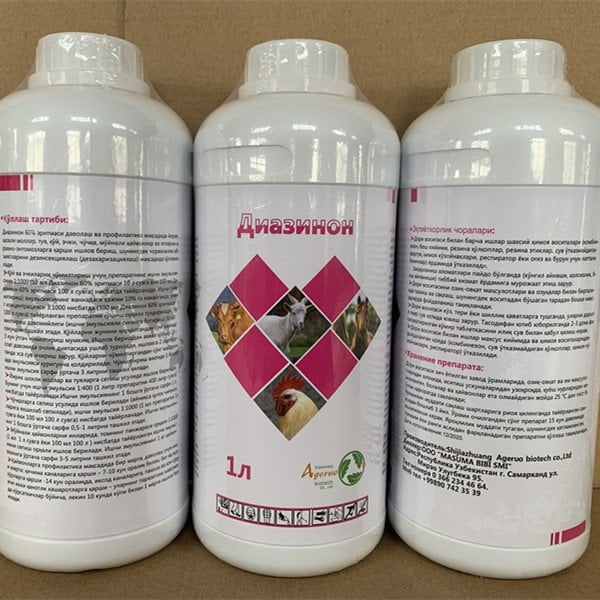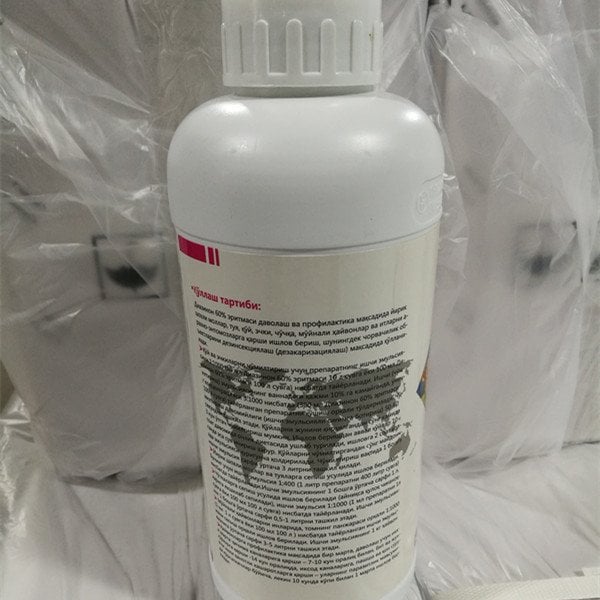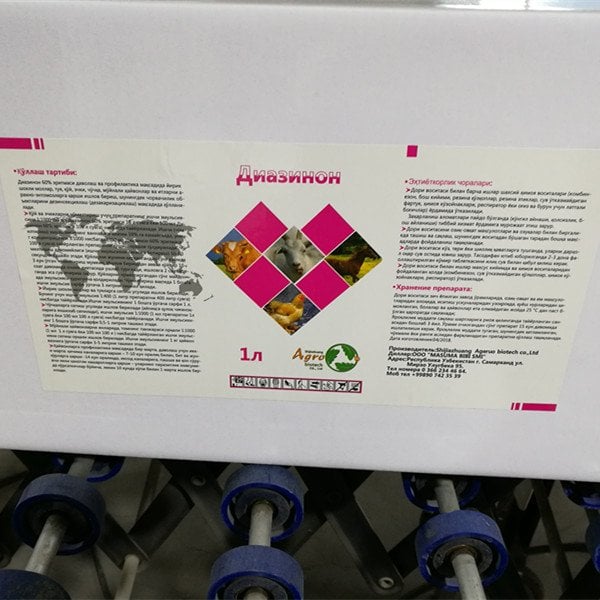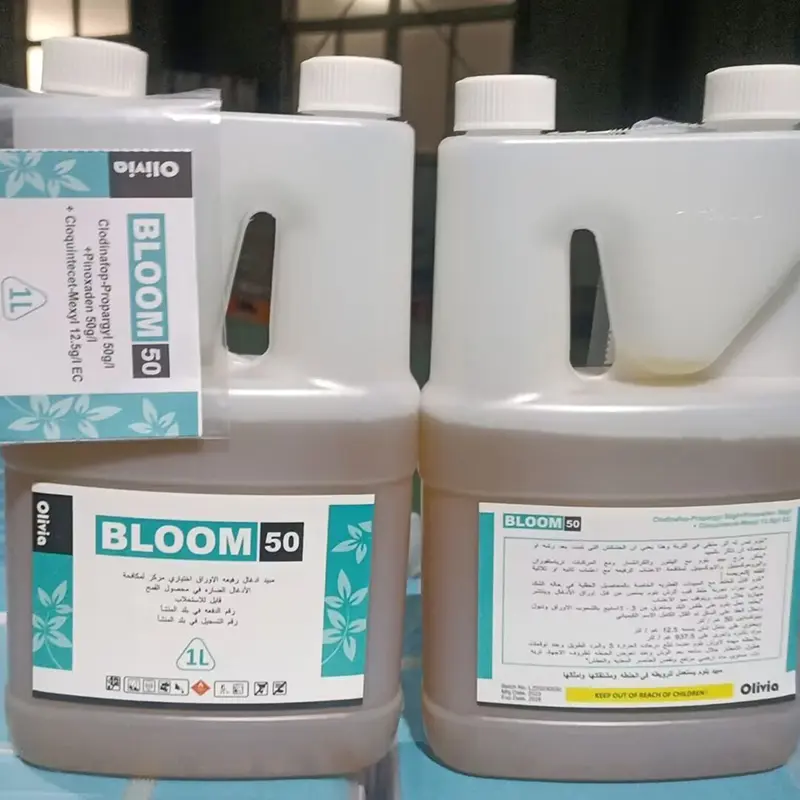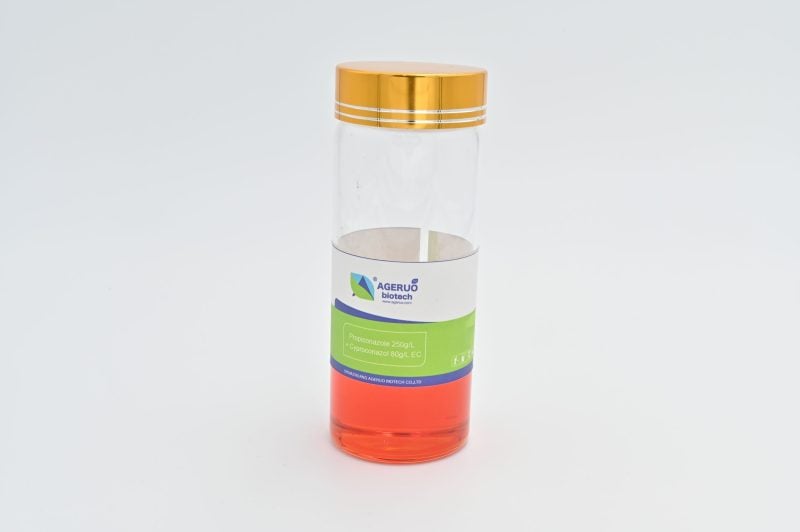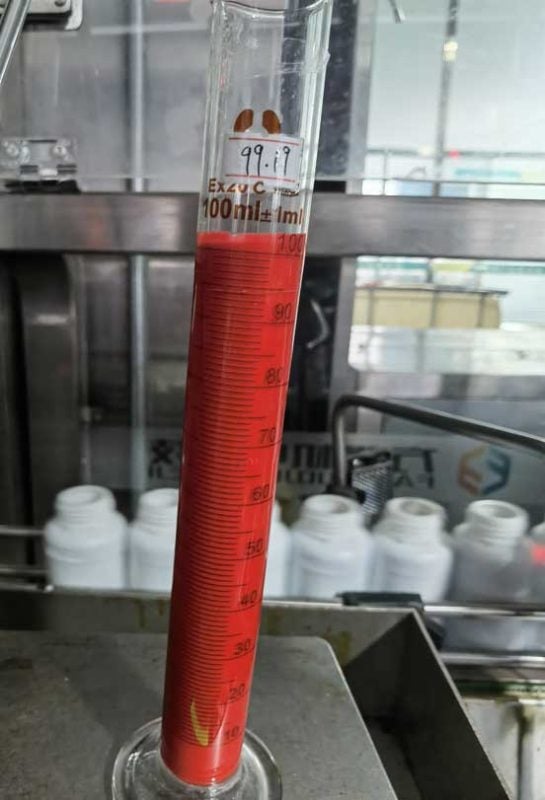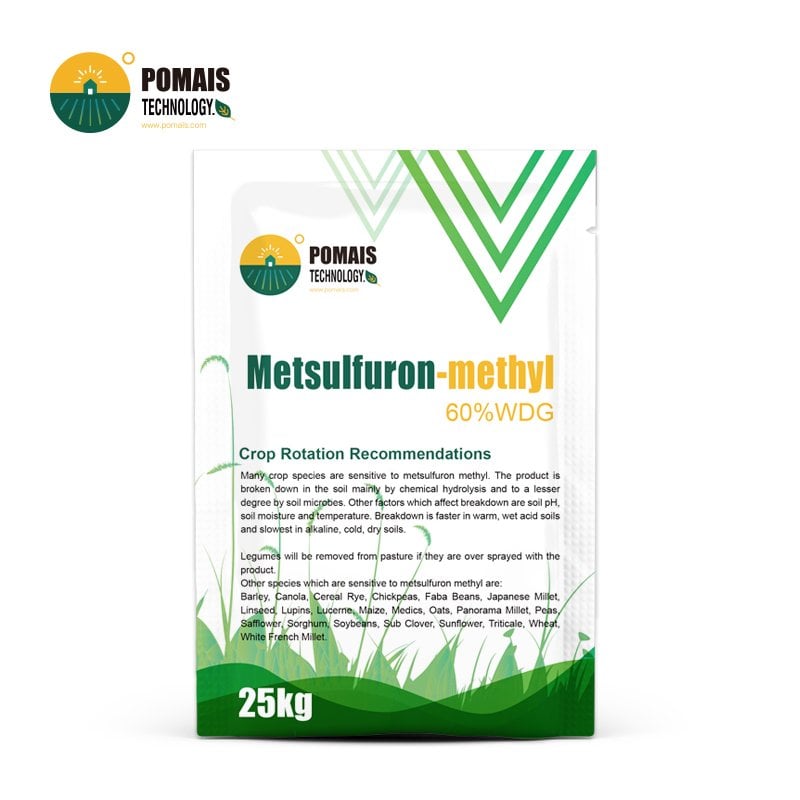Diazinon Insecticide | Broad-Spectrum Organophosphate Pest Control
Diazinon is a powerful and versatile organophosphate insecticide widely used in agriculture and livestock management. Known for its fast action and broad pest spectrum, Diazinon offers effective control of both aboveground and soil-dwelling insects, making it a preferred choice for farmers who need consistent and economical pest protection.
Whether you’re fighting grubs in peanuts, aphids in cotton, or even tumor fly larvae in cattle, Diazinon delivers dependable control. With multiple formulations such as Diazinon 600g/L EC and granular blends, it fits a wide range of field applications—from foliar sprays to soil treatments—and performs well in both crop and animal health systems.
- Product Name: Diazinon
- Common Brand Names: Basudin, Neocidol, Nucidol
- Formulations: 600g/L EC, 5% GR, mixed products with abamectin, phoxim, clothianidin
- Mode of Action: Acetylcholinesterase inhibitor; causes paralysis and death in target insects
- Target Use: Pest control in rice, cotton, peanut, wheat, root herbs, and cattle
- Application Methods: Foliar spray, soil broadcasting (granules), injection (veterinary use)
- Special Advantage: Low toxicity to livestock compared to similar organophosphates
If you’re looking for a proven insecticide that works on multiple pest types, supports flexible application, and can be used in both plant and animal systems, Diazinon is your go-to solution.
- Designed for Professional Buyers & Bulk Orders
- This product is available for business purchase and large-scale distribution.
- We support custom packaging, labeling, and formulation to meet your market needs.
- Let’s build your brand together.

About Diazinon Insecticide | Broad-Spectrum Organophosphate Pest Control
About Diazinon Insecticide | Broad-Spectrum Organophosphate Pest Control
| Common Name | Diazinon, Basudin, Neocidol, Nucidol |
| Active Ingredient | Diazinon |
| Chemical Formula | C4H4N2O |
| CAS Number | 333-41-5 |
| Formulations Available | 600g/L EC |
| Mixed Formulations | – Abamectin 0.2% + Diazinon 4.8% GR – Phoxim 25% + Diazinon 15% EC – Clothianidin 0.5% + Diazinon 4.5% GR |
| Mode of Action | Acetylcholinesterase inhibitor; disrupts nerve conduction, leading to paralysis and death in pests |
| Target Pests | Apple beetles, Grubs, Cutworms, Aphids, Bovine tumor fly larvae |
| Target Crops | Rice, Cotton, Wheat, Peanut, Atractylodes |
| Dosage | – Rice: 1350-1800 ml/ha (Chilo suppressalis) – Cotton: 1200-2400 ml/ha (Aphids) – Peanut: 12,000-18,000 g/ha (Grubs) |
| Application Method | Foliar spray, Broadcast spread |
| Advantages | Broad-spectrum pest control, low toxicity to livestock, effective mixed formulations for enhanced performance |
| Packaging | Customizable based on customer requirements |
| Storage | Store in a cool, dry place, away from direct sunlight and moisture |
Diazinon is a versatile and effective organophosphate insecticide widely used in both crop protection and livestock management. With its broad-spectrum control, low toxicity to livestock, and availability in various formulations, Diazinon is a valuable tool for farmers looking to protect their crops from damaging pests while ensuring the safety of their animals. Its compatibility with other insecticides also enhances its usefulness in integrated pest management programs.
For more details on specific formulations, customized packaging, or technical guidance, feel free to contact us. We are committed to providing the best pest control solutions for your agricultural and livestock needs.
How Diazinon Works: Stops Insects by Disrupting Their Nervous System
Diazinon is not just a surface killer—it targets the core nervous system of insects. Once an insect comes into contact with or ingests Diazinon, it begins a chain reaction that quickly leads to paralysis and death.
What Exactly Happens?
Diazinon works by inhibiting an enzyme called acetylcholinesterase (AChE). This enzyme is essential for breaking down a chemical called acetylcholine, which is used to send signals between nerve cells in insects.
When Diazinon blocks AChE:
- Acetylcholine builds up in the insect’s nervous system
- The insect’s nerves keep firing uncontrollably
- Muscles become paralyzed, leading to loss of movement
- Eventually, the insect dies from nervous system failure
This entire process happens quickly—especially in soft-bodied insects like aphids, grubs, and cutworms—making Diazinon highly effective even in early-stage infestations.
Is Diazinon a contact or systemic insecticide?
Diazinon is primarily a contact and stomach poison, which means it kills insects:
- On contact with sprayed surfaces
- When insects feed on treated plants or soil
It does not move systemically through the plant like some newer insecticides. But it makes up for that with strong residual activity on the leaf surface and in the soil.
What does Diazinon kill?
Diazinon provides broad-spectrum control against many types of pests, including:
- Apple beetles
- Grubs (larvae of scarab beetles)
- Cutworms
- Aphids
- Termites (in some soil-applied programs)
- Bovine tumor fly larvae (when used in livestock)
Whether it’s chewing, sucking, or burrowing—if it’s an insect, Diazinon probably stops it.
Understanding Diazinon’s Behavior: Contact Power with Soil-Active Strength
When we talk about insecticides, it’s important to know not only how they kill pests, but also how they behave once applied—where they go, how long they stay active, and how well they work under different conditions.
Diazinon is classified as a non-systemic insecticide, which means it doesn’t travel through the plant’s internal transport system like some modern systemic options. Instead, it works primarily through:
1. Contact Action
Diazinon sits on the surface of leaves, stems, and soil particles, ready to kill insects the moment they touch or feed on treated areas. This makes it especially effective against pests like:
- Cutworms, which climb and feed on plant stems at night
- Aphids, which gather on new growth and leaf undersides
- Grubs and soil insects, which move through the upper soil layer in search of roots
Because of its contact mode, thorough coverage during spraying is essential. When using Diazinon EC formulations, ensuring uniform leaf wetting is key to maximizing efficacy.
2. Stomach Poisoning Action
Insects that feed on treated plant parts or roots also ingest Diazinon, leading to the same nerve disruption effect from the inside out. This dual-action—contact plus ingestion—makes Diazinon effective against both surface feeders and underground pests.
3. Soil Activity and Persistence
One of Diazinon’s unique advantages is its soil activity, especially when used in granule form (Diazinon GR).
- Diazinon granules are spread across the soil and activated by moisture
- As they dissolve, the active ingredient remains near the surface, targeting grubs, wireworms, and cutworms before they reach the plant root zone
- This action is especially useful in crops like peanuts and atractylodes, which are vulnerable to early underground pest damage
So how long does Diazinon last in the soil?
Under normal conditions, Diazinon can remain effective for 1–2 weeks post-application. Its persistence depends on factors such as:
- Soil type (binds more strongly in clay)
- Moisture (irrigation or rainfall can activate or move it)
- Temperature (warmer weather accelerates breakdown)
4. Environmental Interaction
While Diazinon does not move systemically in plants, it is semi-mobile in soil—meaning it may move slightly downwards but stays near the root zone, where most soil insects live. This helps maintain its targeted action with minimal leaching if applied correctly.
Note: Because of its non-systemic nature, reapplication may be necessary during long pest cycles or after heavy rainfall.
Summary: What This Means in the Field
| Property | Behavior |
|---|---|
| Systemic | No systemic movement in plants |
| Contact Action | Strong surface kill on leaves and stems |
| Stomach Action | Effective when insects feed on treated tissue or soil |
| Soil Activity | Strong, especially in granular form |
| Persistence | Moderate (7–14 days depending on conditions) |
| Ideal For | Both aboveground pests and soil-dwelling insects |
In short, Diazinon protects where the pests live and feed—not where the plant hides it. This makes it a direct, aggressive, and reliable choice for fast pest knockdown in field and livestock systems alike.
Target Crops and Insects Controlled: Where Diazinon Delivers
Diazinon is trusted by farmers across the globe because it works on many types of crops and controls a wide range of insect pests—both above and below the ground. It is especially valued in situations where pests attack early in the crop cycle or stay hidden in the soil, making other insecticides less effective.
Key Crop Applications and Target Pests
| Crop | Target Pest(s) | Formulation | Dosage | Application Method |
|---|---|---|---|---|
| Rice | Rice stem borer (Chilo suppressalis) | 50% EC | 1350–1800 ml/ha | Foliar spray at early infestation |
| Cotton | Aphids, cutworms | 50% EC | 1200–2400 ml/ha | Foliar spray on lower and upper leaf canopy |
| Peanut | Grubs, soil beetle larvae | 5% GR | 12,000–18,000 g/ha | Broadcast spread and irrigate lightly |
| Atractylodes (medicinal root) | Cutworms | 5% GR | 30,000–45,000 g/ha | Uniform broadcasting over the soil before planting |
| Wheat | Wireworms, underground pests | 50% EC | Based on pest density | Soil-directed spray or seed row application |
| Vegetables (e.g., tomatoes, cabbage) | Aphids, whiteflies, leafminers | 600g/L EC | 1000–1500 ml/ha | Foliar spray every 7–10 days if needed |
For every pest stage—egg, larva, or adult—Diazinon provides timely control when applied correctly.
Applications in Animal Health
Diazinon is also used in the veterinary field, especially for controlling external parasites in cattle and livestock.
| Animal | Target Parasite | Application Method | Notes |
|---|---|---|---|
| Cattle | Bovine tumor fly larvae (Hypoderma bovis) | Injectable or pour-on solution | Diazinon helps kill larvae under the skin without harming the animal |
| Sheep, Goats | Ticks, lice | Spray or dip | Used under veterinary guidance |
Does Diazinon kill termites or bed bugs?
- Termites: Diazinon is sometimes used in soil treatment programs to kill termites before construction or under tree basins. However, dedicated termiticides are preferred for full-structure protection.
- Bed bugs: Diazinon was historically used in home pest control, but it is no longer recommended or registered for domestic indoor use due to toxicity and regulatory limits in many countries.
If you are considering diazinon for bed bugs or termites, always check local label permissions and usage regulations.
Summary of What Diazinon Kills
Above-ground pests:
- Aphids
- Cutworms
- Leafminers
- Whiteflies
- Apple beetles
Soil pests:
- Grubs
- Root maggots
- Wireworms
- Golden needle beetles
Livestock pests:
- Tumor fly larvae
- Lice
- External ticks
Recommended Application Methods and Dosage: Get It Right, Get Results
The effectiveness of Diazinon insecticide doesn’t just depend on its chemical strength—it also depends on how, when, and where you apply it. Using the correct formulation, dosage, and timing will ensure maximum pest control and reduce the chance of pest resistance or crop injury.
1. Diazinon EC (Emulsifiable Concentrate)
Best for: Foliar application on above-ground pests such as aphids, cutworms, rice stem borers, whiteflies.
Application Guidelines:
- Dilution: Mix with clean water in a well-calibrated sprayer. Stir or agitate to maintain even suspension.
- Spray Coverage: Ensure complete coverage of leaf surfaces, including undersides where pests often hide.
- Timing: Apply at the first sign of pest infestation; repeat as needed based on pressure, usually every 7–14 days.
| Crop | Pest | Formulation | Rate (ml/ha) | Notes |
|---|---|---|---|---|
| Rice | Stem borer | 50% EC | 1350–1800 | Apply early in larval stage |
| Cotton | Aphids | 50% EC | 1200–2400 | Use higher rate in dense foliage |
| Vegetables | Leafminer, aphid | 600g/L EC | 1000–1500 | Use fine mist sprayer for uniformity |
For small-scale application: Use 10–20 ml of Diazinon 50% EC per 15L of water in a knapsack sprayer.
2. Diazinon GR (Granular Formulation)
Best for: Soil-dwelling pests like grubs, wireworms, and cutworms that live below the plant canopy.
Application Guidelines:
- Broadcasting: Evenly spread granules over the target area using a mechanical spreader or by hand for small plots.
- Water Activation: Lightly irrigate the area after application to help granules release the active ingredient into the upper soil layer.
- Timing: Apply before or at planting, or at early growth stages when soil insects are most active.
| Crop | Pest | Formulation | Rate (g/ha) | Application Timing |
|---|---|---|---|---|
| Peanut | Grubs | 5% GR | 12,000–18,000 | At sowing or early growth |
| Atractylodes | Cutworms | 5% GR | 30,000–45,000 | Before transplanting |
| Wheat | Soil pests | 5% GR | 10,000–15,000 | As basal treatment in seed row |
Granules are ideal for crops with sensitive root systems or when spray application is impractical.
3. Livestock Use (Veterinary-Supervised)
- Injection or Pour-on: For controlling tumor fly larvae in cattle, use under veterinary supervision with specific veterinary formulations.
- Dipping or Spraying: For lice or ticks in goats or sheep, use low-concentration solutions and monitor animal stress closely.
- Note: Never use crop-formulated Diazinon EC or GR directly on animals. Always follow licensed veterinary instructions.
General Safety Tips During Application
- Always wear gloves, goggles, and protective clothing
- Avoid applying during midday heat or before heavy rainfall
- Keep people and animals away from treated fields until spray has dried or as per re-entry guidelines
- Clean sprayers thoroughly after each use
A well-timed and correctly applied dose of Diazinon can mean the difference between a small infestation—and a failed crop.
Why Choose Diazinon? Key Advantages That Make It Work in the Field
When pest pressure hits hard, farmers don’t just need a pesticide—they need one that’s reliable, versatile, and cost-effective. That’s exactly what Diazinon insecticide delivers.
Whether you manage a rice paddy in Asia, a cotton field in Africa, or a peanut crop in South America, Diazinon has built a reputation over decades for its broad-spectrum action, fast knockdown, and safe application across crops and livestock systems.
1. Broad-Spectrum Insect Control
Diazinon controls both:
- Above-ground pests: Aphids, cutworms, whiteflies, beetles
- Below-ground pests: Grubs, root maggots, soil larvae
- Livestock parasites: Tumor fly larvae, ticks, lice (veterinary-approved use only)
This makes it a multi-use solution across the farm—one product that works in both soil and spray applications.
2. Versatile Formulation Range
With Emulsifiable Concentrate (EC) and Granular (GR) options, Diazinon adapts to a variety of field conditions:
- EC: Ideal for foliar sprays and quick knockdown
- GR: Perfect for soil-borne pests in early-stage crops
- Mixed products: With abamectin, phoxim, and clothianidin, for enhanced activity and resistance management
Whether you’re using manual sprayers or broadcasting by tractor, Diazinon can be fitted into your existing operation without major changes.
3. Low Toxicity to Livestock
Unlike some older organophosphates, Diazinon has:
- Lower toxicity in mammalian species, especially cattle and goats
- Proven safe under proper veterinary guidance
- Suitable for integrated crop-livestock farms seeking dual-purpose protection
This makes Diazinon a practical choice where plant protection and animal safety must co-exist.
4. Compatible with IPM Programs
Diazinon complements Integrated Pest Management (IPM) strategies:
- Can be rotated with systemic or biological insecticides
- Works well in combination treatments against resistant pest populations
- Helps reduce over-reliance on synthetic pyrethroids or neonicotinoids
5. Affordable and Accessible
- High active ingredient load = fewer applications and lower cost per hectare
- Long field history means farmers are already familiar with usage
- Available in bulk and retail packaging for different market levels
Diazinon is not only effective—it’s practical, affordable, and field-proven.
Formulations and OEM Options: Built for Flexibility, Designed for the Market
Whether you’re targeting mass-market crop protection, public sector supply, or building your own branded pesticide line, Diazinon offers the formulation variety and service flexibility to meet your business goals.
We offer both single-active and dual-active formulations, including custom OEM labeling and packaging options suited for global agricultural supply chains.
Available Formulations
1. Emulsifiable Concentrate (EC)
<
| Product | Description | Application |
|---|---|---|
| Diazinon 600g/L EC | High-load EC for field spraying | Rice, cotton, vegetables |
| Diazinon 50% EC | Standard-rate EC widely used in row crops | Wheat, cotton, orchard crops |
| Diazinon 19.9% + Abamectin 0.1% EC | Contact + stomach action combo | Foliar use for chewing/sucking pests |
| Phoxim 25% + Diazinon 15% EC | Dual-organophosphate blend for enhanced knockdown | Cotton, vegetables |
| Phoxim 11% + Diazinon 5% EC | Lower rate EC for rotational use | Aphid/cutworm-focused programs |
2. Granular Formulations (GR)
| Product | Description | Application |
|---|---|---|
| Diazinon 5% GR | Soil insecticide for broadcast spreading | Peanuts, root herbs, vegetables |
| Abamectin 0.2% + Diazinon 4.8% GR | Combo for soil pests with larvicidal boost | Peanuts, rice paddies |
| Clothianidin 0.5% + Diazinon 4.5% GR | Neonicotinoid + organophosphate for broader spectrum | Row crops under high pressure |
| Fosthiazate 10.5% + Diazinon 2.5% GR | Dual-mode action against nematodes and soil insects | High-value crops, medicinal plants |
These blends are developed for enhanced resistance management, improved residual control, and broader pest spectrum coverage.
Packaging Options
| Container Type | Available Sizes |
|---|---|
| HDPE Bottles (EC) | 100ml, 250ml, 500ml, 1L |
| Jerrycans (EC) | 5L, 10L, 20L |
| Bulk Drums (EC) | 200L (UN-rated export) |
| Granular Bags | 1kg, 5kg, 10kg, 25kg (PP woven bags or foil bags) |
| Custom OEM | Multilingual labels, logo design, QR codes, anti-counterfeit |
We offer:
- Full OEM and private label services
- Packaging and language localization by country or region
- Regulatory document bundles: COA, SDS, TDS, product label templates
- Custom barcode, tracking, and serialization for distributors
Whether you’re building a national pesticide brand, supplying a government tender, or launching a co-branded crop protection line, we support full-stack OEM execution—from production to packaging to documentation.
Diazinon is more than a product. It’s a flexible platform for your growth in global crop protection.
Storage, Safety, and Environmental Handling
Diazinon is a powerful tool in pest control, but like all chemical insecticides, it must be handled with care and stored correctly to ensure both user safety and environmental responsibility. Whether you’re a farm operator, distributor, or applicator, following these guidelines will ensure safe use and compliance with international standards.
Safe Handling Practices
- Wear protective gear: Always use gloves, goggles, long sleeves, and a respirator mask when handling Diazinon—especially during mixing and spraying.
- Avoid skin and eye contact: If contact occurs, wash immediately with clean water and soap.
- No eating or smoking: Never handle Diazinon while eating, drinking, or smoking to avoid accidental ingestion.
- Wash thoroughly after use: Especially before meals or handling livestock.
Storage Conditions
| Condition | Guideline |
|---|---|
| Temperature | Store in a cool, dry place (5–30°C recommended) |
| Light | Keep away from direct sunlight to prevent chemical degradation |
| Moisture | Avoid exposure to humidity—keep containers sealed tightly |
| Ventilation | Store in a well-ventilated area, away from flame or spark sources |
| Segregation | Keep away from food, feed, seeds, and water sources |
| Child safety | Store out of reach of children and unauthorized personnel |
Diazinon remains stable under proper storage conditions for up to 2 years, ensuring long shelf life and consistent field performance.
Transport and Distribution Safety
- Pack Diazinon products in UN-approved packaging for export (EC and GR types)
- Comply with GHS labeling and local transport regulations (land, sea, or air)
- Ensure proper documentation accompanies each shipment (COA, SDS, export declaration)
- Avoid exposure to heat, sparks, or mechanical damage during transit
Environmental Use Guidelines
Diazinon is highly effective against insects—but caution must be taken to avoid off-target harm, especially to beneficial insects and aquatic systems.
- Do not apply near water bodies: Avoid contamination of streams, ponds, aquaculture, or irrigation channels.
- Prevent spray drift: Use low-pressure nozzles and avoid application in high winds.
- Manage leftover pesticide and rinsate: Never dump in drains or open fields; dispose of as per local regulations.
- Container disposal: Triple rinse empty containers and puncture before disposal. Follow national pesticide container disposal programs.
Emergency Measures
| Scenario | Action |
|---|---|
| Skin contact | Wash with soap and water for at least 15 minutes |
| Eye contact | Flush eyes with clean water; seek medical attention |
| Inhalation | Move to fresh air; provide oxygen if breathing is difficult |
| Ingestion | Do not induce vomiting; seek medical attention immediately |
For large spills, contain the area with absorbent materials and contact local hazardous waste authorities for proper cleanup.
Frequently Asked Questions (FAQ) & Conversion Guide
What does Diazinon kill?
Diazinon controls a wide range of pests, including:
- Above-ground pests like aphids, leafminers, whiteflies, cutworms
- Soil-dwelling insects such as grubs, root maggots, wireworms
- Livestock parasites like tumor fly larvae and external lice (veterinary use)
Its contact and ingestion action make it effective at different insect life stages, from larvae to adults.
Is Diazinon systemic?
No. Diazinon is a non-systemic insecticide, meaning it does not travel through the plant’s vascular system. It works by remaining on plant or soil surfaces, where it directly affects insects that touch or consume treated areas.
Can Diazinon be used indoors for household pests?
In many countries, Diazinon is no longer approved for domestic indoor use due to safety concerns. While it may historically have been used against pests like cockroaches or bed bugs, it is now mainly used in agricultural and veterinary settings. Always follow national regulatory guidelines.
Does Diazinon kill termites?
Diazinon may offer some effectiveness against termites when used as a soil barrier treatment, but it is not considered a frontline termiticide today. For structural termite control, products specifically labeled for that use are more appropriate.
What is the recommended Diazinon insecticide dosage?
Dosage varies by formulation and pest target:
- EC formulations (e.g. 600g/L): 1200–2400 ml/ha for foliar pests
- GR formulations (e.g. 5% granules): 12,000–45,000 g/ha for soil pests
- Veterinary use: Always follow professional veterinary guidance
Refer to crop-specific charts for precision application rates.
Can Diazinon be used in tank mixes?
Yes, Diazinon is often mixed with other insecticides like abamectin, phoxim, or clothianidin to broaden pest control or reduce resistance risk. However, always conduct a jar test before large-scale application to check compatibility.
How can I purchase Diazinon or request OEM service?
We support:
- Bulk supply for agricultural distributors and government procurement
- OEM/private label services with custom logo, packaging, and registration documents
- Multi-formulation availability (EC, GR, premix) to meet varied market needs
- Samples and technical dossiers for regulatory filing or field trials
Ready to Take the Next Step?
If you’re looking for a trusted supplier of Diazinon insecticide, planning to launch your own branded product, or searching for a flexible partner who can help with everything from manufacturing to packaging to export—we are ready to support you.
Services We Offer:
- Samples for field testing or tender qualification
- COA, MSDS, TDS, and field trial documentation
- Multilingual label and carton design
- Regulatory support for Middle East, Africa, Latin America, and Asia
- Short production lead times and global logistics coordination
Diazinon is more than just a pesticide—it’s a reliable solution for integrated pest control across crops, soil, and livestock.
Contact us now to request a quote, start OEM discussions, or get professional advice for your local application needs.
| Common Name | Diazinon, Basudin, Neocidol, Nucidol |
| Active Ingredient | Diazinon |
| Chemical Formula | C4H4N2O |
| CAS Number | 333-41-5 |
| Formulations Available | 600g/L EC |
| Mixed Formulations | – Abamectin 0.2% + Diazinon 4.8% GR – Phoxim 25% + Diazinon 15% EC – Clothianidin 0.5% + Diazinon 4.5% GR |
| Mode of Action | Acetylcholinesterase inhibitor; disrupts nerve conduction, leading to paralysis and death in pests |
| Target Pests | Apple beetles, Grubs, Cutworms, Aphids, Bovine tumor fly larvae |
| Target Crops | Rice, Cotton, Wheat, Peanut, Atractylodes |
| Dosage | – Rice: 1350-1800 ml/ha (Chilo suppressalis) – Cotton: 1200-2400 ml/ha (Aphids) – Peanut: 12,000-18,000 g/ha (Grubs) |
| Application Method | Foliar spray, Broadcast spread |
| Advantages | Broad-spectrum pest control, low toxicity to livestock, effective mixed formulations for enhanced performance |
| Packaging | Customizable based on customer requirements |
| Storage | Store in a cool, dry place, away from direct sunlight and moisture |
Diazinon is a versatile and effective organophosphate insecticide widely used in both crop protection and livestock management. With its broad-spectrum control, low toxicity to livestock, and availability in various formulations, Diazinon is a valuable tool for farmers looking to protect their crops from damaging pests while ensuring the safety of their animals. Its compatibility with other insecticides also enhances its usefulness in integrated pest management programs.
For more details on specific formulations, customized packaging, or technical guidance, feel free to contact us. We are committed to providing the best pest control solutions for your agricultural and livestock needs.
How Diazinon Works: Stops Insects by Disrupting Their Nervous System
Diazinon is not just a surface killer—it targets the core nervous system of insects. Once an insect comes into contact with or ingests Diazinon, it begins a chain reaction that quickly leads to paralysis and death.
What Exactly Happens?
Diazinon works by inhibiting an enzyme called acetylcholinesterase (AChE). This enzyme is essential for breaking down a chemical called acetylcholine, which is used to send signals between nerve cells in insects.
When Diazinon blocks AChE:
- Acetylcholine builds up in the insect’s nervous system
- The insect’s nerves keep firing uncontrollably
- Muscles become paralyzed, leading to loss of movement
- Eventually, the insect dies from nervous system failure
This entire process happens quickly—especially in soft-bodied insects like aphids, grubs, and cutworms—making Diazinon highly effective even in early-stage infestations.
Is Diazinon a contact or systemic insecticide?
Diazinon is primarily a contact and stomach poison, which means it kills insects:
- On contact with sprayed surfaces
- When insects feed on treated plants or soil
It does not move systemically through the plant like some newer insecticides. But it makes up for that with strong residual activity on the leaf surface and in the soil.
What does Diazinon kill?
Diazinon provides broad-spectrum control against many types of pests, including:
- Apple beetles
- Grubs (larvae of scarab beetles)
- Cutworms
- Aphids
- Termites (in some soil-applied programs)
- Bovine tumor fly larvae (when used in livestock)
Whether it’s chewing, sucking, or burrowing—if it’s an insect, Diazinon probably stops it.
Understanding Diazinon’s Behavior: Contact Power with Soil-Active Strength
When we talk about insecticides, it’s important to know not only how they kill pests, but also how they behave once applied—where they go, how long they stay active, and how well they work under different conditions.
Diazinon is classified as a non-systemic insecticide, which means it doesn’t travel through the plant’s internal transport system like some modern systemic options. Instead, it works primarily through:
1. Contact Action
Diazinon sits on the surface of leaves, stems, and soil particles, ready to kill insects the moment they touch or feed on treated areas. This makes it especially effective against pests like:
- Cutworms, which climb and feed on plant stems at night
- Aphids, which gather on new growth and leaf undersides
- Grubs and soil insects, which move through the upper soil layer in search of roots
Because of its contact mode, thorough coverage during spraying is essential. When using Diazinon EC formulations, ensuring uniform leaf wetting is key to maximizing efficacy.
2. Stomach Poisoning Action
Insects that feed on treated plant parts or roots also ingest Diazinon, leading to the same nerve disruption effect from the inside out. This dual-action—contact plus ingestion—makes Diazinon effective against both surface feeders and underground pests.
3. Soil Activity and Persistence
One of Diazinon’s unique advantages is its soil activity, especially when used in granule form (Diazinon GR).
- Diazinon granules are spread across the soil and activated by moisture
- As they dissolve, the active ingredient remains near the surface, targeting grubs, wireworms, and cutworms before they reach the plant root zone
- This action is especially useful in crops like peanuts and atractylodes, which are vulnerable to early underground pest damage
So how long does Diazinon last in the soil?
Under normal conditions, Diazinon can remain effective for 1–2 weeks post-application. Its persistence depends on factors such as:
- Soil type (binds more strongly in clay)
- Moisture (irrigation or rainfall can activate or move it)
- Temperature (warmer weather accelerates breakdown)
4. Environmental Interaction
While Diazinon does not move systemically in plants, it is semi-mobile in soil—meaning it may move slightly downwards but stays near the root zone, where most soil insects live. This helps maintain its targeted action with minimal leaching if applied correctly.
Note: Because of its non-systemic nature, reapplication may be necessary during long pest cycles or after heavy rainfall.
Summary: What This Means in the Field
| Property | Behavior |
|---|---|
| Systemic | No systemic movement in plants |
| Contact Action | Strong surface kill on leaves and stems |
| Stomach Action | Effective when insects feed on treated tissue or soil |
| Soil Activity | Strong, especially in granular form |
| Persistence | Moderate (7–14 days depending on conditions) |
| Ideal For | Both aboveground pests and soil-dwelling insects |
In short, Diazinon protects where the pests live and feed—not where the plant hides it. This makes it a direct, aggressive, and reliable choice for fast pest knockdown in field and livestock systems alike.
Target Crops and Insects Controlled: Where Diazinon Delivers
Diazinon is trusted by farmers across the globe because it works on many types of crops and controls a wide range of insect pests—both above and below the ground. It is especially valued in situations where pests attack early in the crop cycle or stay hidden in the soil, making other insecticides less effective.
Key Crop Applications and Target Pests
| Crop | Target Pest(s) | Formulation | Dosage | Application Method |
|---|---|---|---|---|
| Rice | Rice stem borer (Chilo suppressalis) | 50% EC | 1350–1800 ml/ha | Foliar spray at early infestation |
| Cotton | Aphids, cutworms | 50% EC | 1200–2400 ml/ha | Foliar spray on lower and upper leaf canopy |
| Peanut | Grubs, soil beetle larvae | 5% GR | 12,000–18,000 g/ha | Broadcast spread and irrigate lightly |
| Atractylodes (medicinal root) | Cutworms | 5% GR | 30,000–45,000 g/ha | Uniform broadcasting over the soil before planting |
| Wheat | Wireworms, underground pests | 50% EC | Based on pest density | Soil-directed spray or seed row application |
| Vegetables (e.g., tomatoes, cabbage) | Aphids, whiteflies, leafminers | 600g/L EC | 1000–1500 ml/ha | Foliar spray every 7–10 days if needed |
For every pest stage—egg, larva, or adult—Diazinon provides timely control when applied correctly.
Applications in Animal Health
Diazinon is also used in the veterinary field, especially for controlling external parasites in cattle and livestock.
| Animal | Target Parasite | Application Method | Notes |
|---|---|---|---|
| Cattle | Bovine tumor fly larvae (Hypoderma bovis) | Injectable or pour-on solution | Diazinon helps kill larvae under the skin without harming the animal |
| Sheep, Goats | Ticks, lice | Spray or dip | Used under veterinary guidance |
Does Diazinon kill termites or bed bugs?
- Termites: Diazinon is sometimes used in soil treatment programs to kill termites before construction or under tree basins. However, dedicated termiticides are preferred for full-structure protection.
- Bed bugs: Diazinon was historically used in home pest control, but it is no longer recommended or registered for domestic indoor use due to toxicity and regulatory limits in many countries.
If you are considering diazinon for bed bugs or termites, always check local label permissions and usage regulations.
Summary of What Diazinon Kills
Above-ground pests:
- Aphids
- Cutworms
- Leafminers
- Whiteflies
- Apple beetles
Soil pests:
- Grubs
- Root maggots
- Wireworms
- Golden needle beetles
Livestock pests:
- Tumor fly larvae
- Lice
- External ticks
Recommended Application Methods and Dosage: Get It Right, Get Results
The effectiveness of Diazinon insecticide doesn’t just depend on its chemical strength—it also depends on how, when, and where you apply it. Using the correct formulation, dosage, and timing will ensure maximum pest control and reduce the chance of pest resistance or crop injury.
1. Diazinon EC (Emulsifiable Concentrate)
Best for: Foliar application on above-ground pests such as aphids, cutworms, rice stem borers, whiteflies.
Application Guidelines:
- Dilution: Mix with clean water in a well-calibrated sprayer. Stir or agitate to maintain even suspension.
- Spray Coverage: Ensure complete coverage of leaf surfaces, including undersides where pests often hide.
- Timing: Apply at the first sign of pest infestation; repeat as needed based on pressure, usually every 7–14 days.
| Crop | Pest | Formulation | Rate (ml/ha) | Notes |
|---|---|---|---|---|
| Rice | Stem borer | 50% EC | 1350–1800 | Apply early in larval stage |
| Cotton | Aphids | 50% EC | 1200–2400 | Use higher rate in dense foliage |
| Vegetables | Leafminer, aphid | 600g/L EC | 1000–1500 | Use fine mist sprayer for uniformity |
For small-scale application: Use 10–20 ml of Diazinon 50% EC per 15L of water in a knapsack sprayer.
2. Diazinon GR (Granular Formulation)
Best for: Soil-dwelling pests like grubs, wireworms, and cutworms that live below the plant canopy.
Application Guidelines:
- Broadcasting: Evenly spread granules over the target area using a mechanical spreader or by hand for small plots.
- Water Activation: Lightly irrigate the area after application to help granules release the active ingredient into the upper soil layer.
- Timing: Apply before or at planting, or at early growth stages when soil insects are most active.
| Crop | Pest | Formulation | Rate (g/ha) | Application Timing |
|---|---|---|---|---|
| Peanut | Grubs | 5% GR | 12,000–18,000 | At sowing or early growth |
| Atractylodes | Cutworms | 5% GR | 30,000–45,000 | Before transplanting |
| Wheat | Soil pests | 5% GR | 10,000–15,000 | As basal treatment in seed row |
Granules are ideal for crops with sensitive root systems or when spray application is impractical.
3. Livestock Use (Veterinary-Supervised)
- Injection or Pour-on: For controlling tumor fly larvae in cattle, use under veterinary supervision with specific veterinary formulations.
- Dipping or Spraying: For lice or ticks in goats or sheep, use low-concentration solutions and monitor animal stress closely.
- Note: Never use crop-formulated Diazinon EC or GR directly on animals. Always follow licensed veterinary instructions.
General Safety Tips During Application
- Always wear gloves, goggles, and protective clothing
- Avoid applying during midday heat or before heavy rainfall
- Keep people and animals away from treated fields until spray has dried or as per re-entry guidelines
- Clean sprayers thoroughly after each use
A well-timed and correctly applied dose of Diazinon can mean the difference between a small infestation—and a failed crop.
Why Choose Diazinon? Key Advantages That Make It Work in the Field
When pest pressure hits hard, farmers don’t just need a pesticide—they need one that’s reliable, versatile, and cost-effective. That’s exactly what Diazinon insecticide delivers.
Whether you manage a rice paddy in Asia, a cotton field in Africa, or a peanut crop in South America, Diazinon has built a reputation over decades for its broad-spectrum action, fast knockdown, and safe application across crops and livestock systems.
1. Broad-Spectrum Insect Control
Diazinon controls both:
- Above-ground pests: Aphids, cutworms, whiteflies, beetles
- Below-ground pests: Grubs, root maggots, soil larvae
- Livestock parasites: Tumor fly larvae, ticks, lice (veterinary-approved use only)
This makes it a multi-use solution across the farm—one product that works in both soil and spray applications.
2. Versatile Formulation Range
With Emulsifiable Concentrate (EC) and Granular (GR) options, Diazinon adapts to a variety of field conditions:
- EC: Ideal for foliar sprays and quick knockdown
- GR: Perfect for soil-borne pests in early-stage crops
- Mixed products: With abamectin, phoxim, and clothianidin, for enhanced activity and resistance management
Whether you’re using manual sprayers or broadcasting by tractor, Diazinon can be fitted into your existing operation without major changes.
3. Low Toxicity to Livestock
Unlike some older organophosphates, Diazinon has:
- Lower toxicity in mammalian species, especially cattle and goats
- Proven safe under proper veterinary guidance
- Suitable for integrated crop-livestock farms seeking dual-purpose protection
This makes Diazinon a practical choice where plant protection and animal safety must co-exist.
4. Compatible with IPM Programs
Diazinon complements Integrated Pest Management (IPM) strategies:
- Can be rotated with systemic or biological insecticides
- Works well in combination treatments against resistant pest populations
- Helps reduce over-reliance on synthetic pyrethroids or neonicotinoids
5. Affordable and Accessible
- High active ingredient load = fewer applications and lower cost per hectare
- Long field history means farmers are already familiar with usage
- Available in bulk and retail packaging for different market levels
Diazinon is not only effective—it’s practical, affordable, and field-proven.
Formulations and OEM Options: Built for Flexibility, Designed for the Market
Whether you’re targeting mass-market crop protection, public sector supply, or building your own branded pesticide line, Diazinon offers the formulation variety and service flexibility to meet your business goals.
We offer both single-active and dual-active formulations, including custom OEM labeling and packaging options suited for global agricultural supply chains.
Available Formulations
1. Emulsifiable Concentrate (EC)
<
| Product | Description | Application |
|---|---|---|
| Diazinon 600g/L EC | High-load EC for field spraying | Rice, cotton, vegetables |
| Diazinon 50% EC | Standard-rate EC widely used in row crops | Wheat, cotton, orchard crops |
| Diazinon 19.9% + Abamectin 0.1% EC | Contact + stomach action combo | Foliar use for chewing/sucking pests |
| Phoxim 25% + Diazinon 15% EC | Dual-organophosphate blend for enhanced knockdown | Cotton, vegetables |
| Phoxim 11% + Diazinon 5% EC | Lower rate EC for rotational use | Aphid/cutworm-focused programs |
2. Granular Formulations (GR)
| Product | Description | Application |
|---|---|---|
| Diazinon 5% GR | Soil insecticide for broadcast spreading | Peanuts, root herbs, vegetables |
| Abamectin 0.2% + Diazinon 4.8% GR | Combo for soil pests with larvicidal boost | Peanuts, rice paddies |
| Clothianidin 0.5% + Diazinon 4.5% GR | Neonicotinoid + organophosphate for broader spectrum | Row crops under high pressure |
| Fosthiazate 10.5% + Diazinon 2.5% GR | Dual-mode action against nematodes and soil insects | High-value crops, medicinal plants |
These blends are developed for enhanced resistance management, improved residual control, and broader pest spectrum coverage.
Packaging Options
| Container Type | Available Sizes |
|---|---|
| HDPE Bottles (EC) | 100ml, 250ml, 500ml, 1L |
| Jerrycans (EC) | 5L, 10L, 20L |
| Bulk Drums (EC) | 200L (UN-rated export) |
| Granular Bags | 1kg, 5kg, 10kg, 25kg (PP woven bags or foil bags) |
| Custom OEM | Multilingual labels, logo design, QR codes, anti-counterfeit |
We offer:
- Full OEM and private label services
- Packaging and language localization by country or region
- Regulatory document bundles: COA, SDS, TDS, product label templates
- Custom barcode, tracking, and serialization for distributors
Whether you’re building a national pesticide brand, supplying a government tender, or launching a co-branded crop protection line, we support full-stack OEM execution—from production to packaging to documentation.
Diazinon is more than a product. It’s a flexible platform for your growth in global crop protection.
Storage, Safety, and Environmental Handling
Diazinon is a powerful tool in pest control, but like all chemical insecticides, it must be handled with care and stored correctly to ensure both user safety and environmental responsibility. Whether you’re a farm operator, distributor, or applicator, following these guidelines will ensure safe use and compliance with international standards.
Safe Handling Practices
- Wear protective gear: Always use gloves, goggles, long sleeves, and a respirator mask when handling Diazinon—especially during mixing and spraying.
- Avoid skin and eye contact: If contact occurs, wash immediately with clean water and soap.
- No eating or smoking: Never handle Diazinon while eating, drinking, or smoking to avoid accidental ingestion.
- Wash thoroughly after use: Especially before meals or handling livestock.
Storage Conditions
| Condition | Guideline |
|---|---|
| Temperature | Store in a cool, dry place (5–30°C recommended) |
| Light | Keep away from direct sunlight to prevent chemical degradation |
| Moisture | Avoid exposure to humidity—keep containers sealed tightly |
| Ventilation | Store in a well-ventilated area, away from flame or spark sources |
| Segregation | Keep away from food, feed, seeds, and water sources |
| Child safety | Store out of reach of children and unauthorized personnel |
Diazinon remains stable under proper storage conditions for up to 2 years, ensuring long shelf life and consistent field performance.
Transport and Distribution Safety
- Pack Diazinon products in UN-approved packaging for export (EC and GR types)
- Comply with GHS labeling and local transport regulations (land, sea, or air)
- Ensure proper documentation accompanies each shipment (COA, SDS, export declaration)
- Avoid exposure to heat, sparks, or mechanical damage during transit
Environmental Use Guidelines
Diazinon is highly effective against insects—but caution must be taken to avoid off-target harm, especially to beneficial insects and aquatic systems.
- Do not apply near water bodies: Avoid contamination of streams, ponds, aquaculture, or irrigation channels.
- Prevent spray drift: Use low-pressure nozzles and avoid application in high winds.
- Manage leftover pesticide and rinsate: Never dump in drains or open fields; dispose of as per local regulations.
- Container disposal: Triple rinse empty containers and puncture before disposal. Follow national pesticide container disposal programs.
Emergency Measures
| Scenario | Action |
|---|---|
| Skin contact | Wash with soap and water for at least 15 minutes |
| Eye contact | Flush eyes with clean water; seek medical attention |
| Inhalation | Move to fresh air; provide oxygen if breathing is difficult |
| Ingestion | Do not induce vomiting; seek medical attention immediately |
For large spills, contain the area with absorbent materials and contact local hazardous waste authorities for proper cleanup.
Frequently Asked Questions (FAQ) & Conversion Guide
What does Diazinon kill?
Diazinon controls a wide range of pests, including:
- Above-ground pests like aphids, leafminers, whiteflies, cutworms
- Soil-dwelling insects such as grubs, root maggots, wireworms
- Livestock parasites like tumor fly larvae and external lice (veterinary use)
Its contact and ingestion action make it effective at different insect life stages, from larvae to adults.
Is Diazinon systemic?
No. Diazinon is a non-systemic insecticide, meaning it does not travel through the plant’s vascular system. It works by remaining on plant or soil surfaces, where it directly affects insects that touch or consume treated areas.
Can Diazinon be used indoors for household pests?
In many countries, Diazinon is no longer approved for domestic indoor use due to safety concerns. While it may historically have been used against pests like cockroaches or bed bugs, it is now mainly used in agricultural and veterinary settings. Always follow national regulatory guidelines.
Does Diazinon kill termites?
Diazinon may offer some effectiveness against termites when used as a soil barrier treatment, but it is not considered a frontline termiticide today. For structural termite control, products specifically labeled for that use are more appropriate.
What is the recommended Diazinon insecticide dosage?
Dosage varies by formulation and pest target:
- EC formulations (e.g. 600g/L): 1200–2400 ml/ha for foliar pests
- GR formulations (e.g. 5% granules): 12,000–45,000 g/ha for soil pests
- Veterinary use: Always follow professional veterinary guidance
Refer to crop-specific charts for precision application rates.
Can Diazinon be used in tank mixes?
Yes, Diazinon is often mixed with other insecticides like abamectin, phoxim, or clothianidin to broaden pest control or reduce resistance risk. However, always conduct a jar test before large-scale application to check compatibility.
How can I purchase Diazinon or request OEM service?
We support:
- Bulk supply for agricultural distributors and government procurement
- OEM/private label services with custom logo, packaging, and registration documents
- Multi-formulation availability (EC, GR, premix) to meet varied market needs
- Samples and technical dossiers for regulatory filing or field trials
Ready to Take the Next Step?
If you’re looking for a trusted supplier of Diazinon insecticide, planning to launch your own branded product, or searching for a flexible partner who can help with everything from manufacturing to packaging to export—we are ready to support you.
Services We Offer:
- Samples for field testing or tender qualification
- COA, MSDS, TDS, and field trial documentation
- Multilingual label and carton design
- Regulatory support for Middle East, Africa, Latin America, and Asia
- Short production lead times and global logistics coordination
Diazinon is more than just a pesticide—it’s a reliable solution for integrated pest control across crops, soil, and livestock.
Contact us now to request a quote, start OEM discussions, or get professional advice for your local application needs.
Related Products
Latest News

